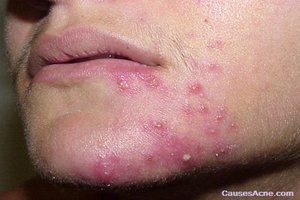
Acne Rosacea – More Than Just A Nuisance
You do not have to be vain to want your face looking its best. In fact, your face is important when it comes to leaving an impression, showing emotion and expressing yourself. But what happens when the impression you are leaving is not what you want it to be? Rosacea, although harmless, can affect the way you look and the way you feel about yourself.
It is a chronic condition that is usually represented by facial redness. This usually occurs on the central part of the face along the cheeks, nose or forehead. Sometimes it travels to the chest, neck, scalp and ears. Rosacea becomes more of a problem when it results in redness that does not seem to go away, papules and pustules. In more severe cases, there can be gritty red eyes, burning or stinging sensations and even a red lobulated nose. All in all, though, rosacea is a harmless, yet upsetting, skin condition.
Rosacea’s primary targets are Caucasians from northwestern European descent. Both men and women can be affected by this skin disorder. Women are three times more likely to suffer from it, but men experience it much worse. The peak age of� rosacea development is between thirty and sixty years.
What Causes Rosacea?
There are several factors that have been shown to trigger rosacea. Among the top contributors are excessive exposure to extreme temperatures and sunlight, high emotional stress, strenuous exercise and anxiety. Foods and drinks can also cause problems. Excessive alcohol consumption, caffeine, spicy foods and foods with a high level of histamine (red wine, yogurt, cured pork and beer) can all trigger flushing and blushing—one of the classic symptoms of rosacea. The histamine-containing foods also have the ability to cause facial flushing in people who are not� suffering from rosacea due to a condition known as histamine intolerance.
It can also be triggered by specific medications or topical agents like creams or gels. There are reports that certain acne and wrinkle treatments can cause rosacea like chemical peels and microdermabrasion. It has also been known to occur from using nasal or topical steroids.
Another possible cause of rosacea is intestinal bacteria. A recent study showed that people with a bacterial overgrowth in the small intestine (detected by using a hydrogen breath test) were more likely to experience rosacea. When these hydrogen-positive people were given a course of absorbable antibiotics, 96% of them had a complete remission of their rosacea symptoms and retesting for bacterial overgrowth resulted in a negative finding.
Treatment Options
Rosacea does not have to be a permanent condition if treated correctly. There are many options to choose from, however, depending on the severity, some people may have to use more advanced forms of treatment.
Behavior modification: If you know what� triggers your acne rosacea like certain foods, stress or excessive sun exposure, it is simply a matter of reducing or eliminating these triggers in day to day life. Limiting sun exposure is usually the first recommended change as it is usually the most common cause. Wearing sunscreen or a wide-brimmed hat to protect your face are two effective ways of preventing rosacea if you absolutely have to be out in the sun for an extended period of time. Stress should also be managed to reduce the occurrence. Finding a new hobby or something that helps relieve stress like exercise can be beneficial in limiting symptoms and outbreaks.
Medicine: In more moderate and severe cases, oral and/or topical antibiotics may be helpful. Many prescription medications can relieve the redness,� pustules and papules that are often part of severe rosacea.� An alpha hydroxy acid peel can also diminish redness and reduce the papules and pustules. Sandalwood oil has been shown to reduce the pustules and redness of rosacea as well.
Lasers: When changes in behavior and medications do not work, laser treatments have been shown to be one of the best treatments for rosacea—specifically for the redness. The capillaries in the dermis layer of skin are penetrated with light. The walls of the capillaries get to a high enough temperature that they become damaged and then absorbed by the body. After a few treatments, it is very possible that the redness will be completely eliminated although there may still be a need for periodic treatments if new capillaries are formed.
Most mild cases of rosacea are often left untreated and many rely on cosmetics to cover up the condition. There is no cure for as the treatments are merely to reduce the signs and symptoms. In many cases, medications will provide temporarily relief from in a couple of weeks, but the redness is likely to return after treatment ends. Treatment that continues for a year or longer has been promising for some people who experienced permanent relief. However, some people do require a lifetime of treatment to keep the symptoms and severity in check.
Knowing what triggers or� causes your rosacea is the first line of defense in keeping it under control. If acne rosacea still continues to be a problem that you struggle with, seeing a dermatologist can significantly help. There is no reason for you to suffer. With a variety of treatment options available, you are sure to find one that works for you.
